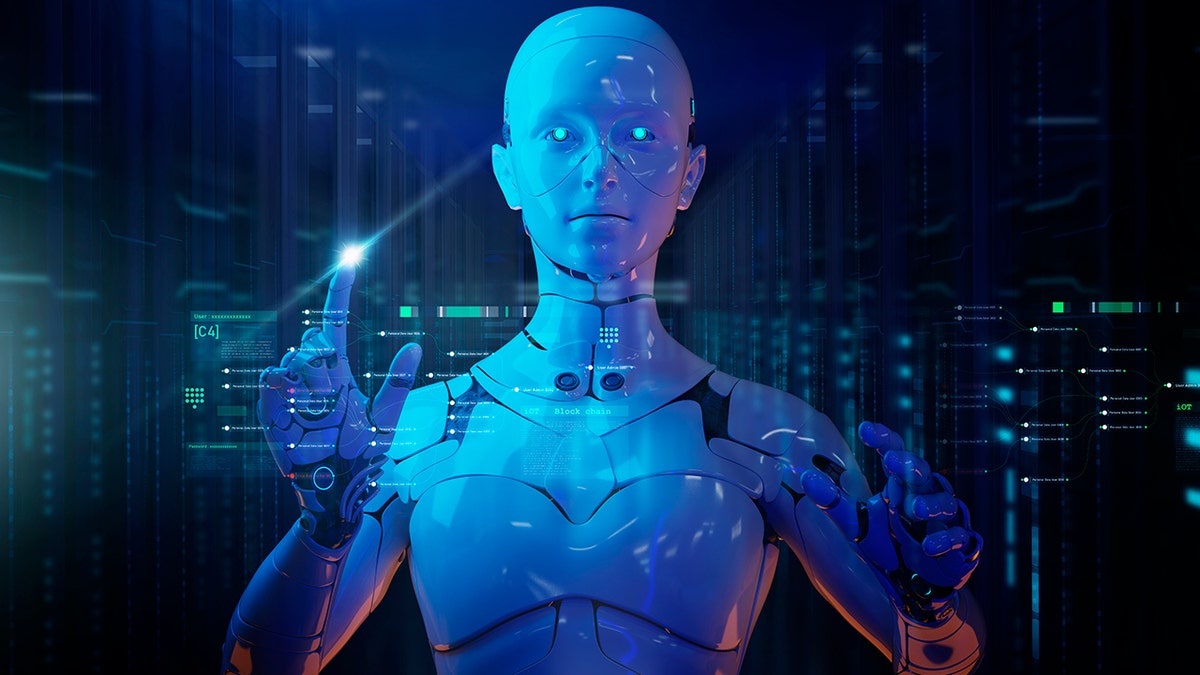Does artificial intelligence pose a threat to humanity?
Fox News correspondent Grady Trimble has the latest on fears the technology will spiral out of control on 'Special Report.'
Robots could soon be cloaked in human-like synthetic skin, similar to the cyborg assassin of the "Terminator" movie franchise, after Stanford University researchers developed an ultra-realistic, self-healing material.
Researchers have been studying and developing convincing skin materials for robots for years, with Stanford professor Zhenan Bao touting the first multi-layer self-healing synthetic electronic skin back in 2012.
More than a decade later, Bao and fellow researchers have taken their studies even further into the future: layers of synthetic skin that can now self-recognize and align with each other when injured, simultaneously allowing the skin to continue functioning while healing.
"We’ve achieved what we believe to be the first demonstration of a multi-layer, thin film sensor that automatically realigns during healing," Christopher B. Cooper, Stanford Ph.D. student and co-author of the study, told SWNS.
OPENAI AND FIGURE DEVELOP TERRIFYINGLY CREEPY HUMANOID ROBOTS FOR THE WORKFORCE

A figure from the movie The Terminator is displayed inside the house where Austrian actor, former champion bodybuilder and former California governor Arnold Schwarzenegger was born, in the southern Austrian village of Thal, October 7, 2011. (REUTERS/Herwig Prammer )
"This is a critical step toward mimicking human skin, which has multiple layers that all re-assemble correctly during the healing process."
Armoring an artificial intelligence-powered robot with life-like skin could be the way of the future, making humans feel more comfortable around such technology, according to SWNS. The material is similar to actor Arnold Schwarzenegger’s cyborg character in "Terminator," which boasted a robotic endoskeleton covered by "living tissue."
AI COULD GO 'TERMINATOR,' GAIN UPPER HAND OVER HUMANS IN DARWINIAN RULES OF EVOLUTION, REPORT WARNS
Similar to human skin, the materials produced by the Stanford researchers can sense thermal, mechanical or electrical changes around it. The current prototype featured in the study was designed to sense pressure.
"It is soft and stretchable. But if you puncture it, slice it, or cut it each layer will selectively heal with itself to restore the overall function. Just like real skin," co-author Sam Root said.

A general view of the buildings of the Main Quadrangle and Hoover Tower on the campus of Stanford University in Palo Alto, California. (David Madison/Getty Images)
"One layer might sense pressure, another temperature, and yet another tension," Root added.
The researchers developed silicone and polypropylene glycol materials that can stretch like human skin without tearing, while magnetic properties allow the skin to self-align.
When the material is warmed, it softens before returning to its normal state. If the material is damaged, it can self-heal in just 24 hours when warmed to 158°F, while the same healing process takes about a week at room temperature.
NEW POWERFUL AI BOT CREATES ANGST AMONG USERS: ARE ROBOTS READY TO TAKE OUR JOBS?
"Combining with magnetic field-guided navigation and induction heating, we may be able to build reconfigurable soft robots that can change shape and sense their deformation on demand," co-author Renee Zhao said.
The researchers said they are next working on making the layers of skin as thin as possible that have different functions, such as a layer that can sense a change in temperature and another layer that senses pressure.
WILL AI EVER BE SMART ENOUGH TO DECIPHER FEDERAL REGULATIONS?

AI robot process automation RPA Document management system DMS for company digital transformation paperless workflow, security cloud digital technology. futuristic 3D robot (iStock)
The research comes as artificial intelligence is having a boom in popularity, including millions of people flocking to use chatbot ChatGPT and create life-like images generated by AI.
CLICK HERE TO GET THE FOX NEWS APP
Amid the tech race to build even more powerful AI systems, humanoid robots are also finding themselves in the spotlight. A Texas-based company is working on "general purpose robots" that will be used to assist with household duties, while a robotics startup backed by OpenAI is working to commercialize humanoid robots for the workplace.





















